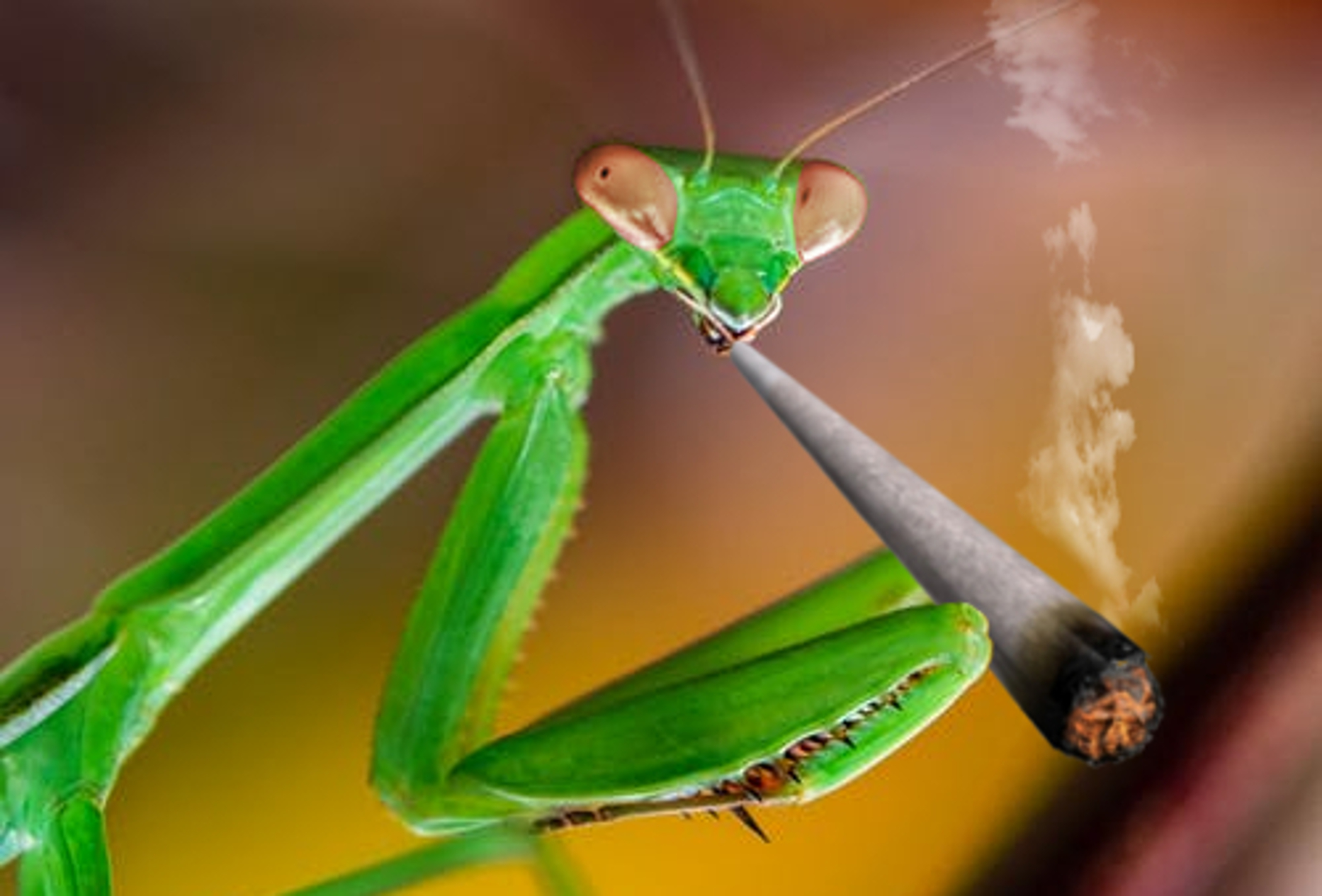
- Growing Guide
-
by John Pot
Back when I just started my garden, I’d rise every morning in the springtime and go check on my wee plants with an aura of dread about me; dread of the sapling scissor, the stem slicer, the scourge of fledgling plants – the horrid cutworm, felling baby plants like timber trees. Little did I know that there are several cheap, easy, and eco-friendly methods for ridding one’s garden of pests and one’s mind of dreams of giant cutworms.
Cannabis, just like any other plant, is susceptible to a variety of bugs, beasts, and blights. A frustrated gardener and/or cannabis grower might be tempted to reach for synthetic pesticides, but these, more often than not, can have unintended consequences like birds (or even your pets!) dying from eating poisoned insects or rodents, as well as beneficial insects like bees and ladybugs succumbing alongside the targeted pest. Luckily, there are preventative measures that could spare you the trouble of having to get rid of anything at all. The best part is that some will benefit your cannabis and crops in other ways too. The first among these is companion planting.
Friendly flowers, helpful herbs – companions for your cannabis
Plants make for wonderful friends, and incredibly useful when they befriend each other. The native farmers of Mesoamerica knew this, utilizing it to great success in what became known as the three sisters method: mielies (that’s “corn” to non-South Africans), beans, and squash. Beans, like all legumes (that includes clovers, peas, rooibos, alfalfa, etc.), are nitrogen fixers. A certain bacteria, rhizobium, infects the rhizosphere (fancy for “roots and stuff around it”) of these legumes while converting airborne nitrogen into a nitrogen compound easily absorbed by the legume’s roots, forming little nodules of sequestered plant food. Mielies are quite fond of nitrogen, especially when it’s time to flower, and they provide a nice support for the beans to climb up on. Meanwhile below on the ground, the umbrella-like leaves of the squash vines block sunlight from any unwanted weeds.

You may recall from last month’s entry that cannabis is a nitrogen-lover too, so why not grow some peas or beans beside them, cutting them at the base after harvesting so your cannabis has a nice deposit of nitrogen to draw from when it’s time to flower? You may also recall from the previous paragraph that I mentioned preventing unwanted weeds – unwanted being the keyword. Clovers, most often considered a weed, are excellent nitrogen fixers with long taproots that draw minerals from deep down that other plants just can’t reach; they also attract pollinators (more on that later) and are lovely in a salad.
Enriching the soil is fantastic and all, but I promised you pest control. Several aromatic herbs and flowers deter aphids, ants, whiteflies, flies, mosquitoes, and even mice with their scent: lavender, lemon balm, thyme, rosemary, rue, mint (just mind you don’t let it take over!), chamomile, dill, and basil. Marigolds and calendulas, the gardener’s favourite, do this too, but with a twist. Their bright flowers in yellow, red, and orange attract the whiteflies and aphids that stick around, distracting them from your cannabis. Sunflowers and nasturtium (“kappertjies”) are also attractive to aphids, snails, and cucumber beetles, with the former providing some shelter from the wind, and the latter being completely edible – leaves, flowers, and seeds and all. When it comes to attracting beneficial insects, try yarrow to bring in aphid-eaters like ladybugs and aphid lions (apparently it boost the production of essential oils in neighbouring plants too, but that’s up for contention). If you’d like a garden full of friendly bees, get some alyssum along with the any of the herbs and flowers listed above; some borage too, since it’s also edible and a nitrogen fixer!
Now, using companion plants to keep away pests isn’t always 100% effective, so it’s important to have an arsenal of remedies up your sleeve if it comes to war; better yet if you can get them at your local shop.
What does beer, cinnamon, and eggshells have in common?
Why, each, among some others, can be used to cure your garden of harmful beasties without harming the environment, your pets, or yourself (no accounting for paper cuts). In a couple of cases you’ll have to make a trip to the garden store, but you won’t have to put out a buck for any poisons.

For ease of reading, here’s a list of common pest and their natural nemesis:
Ants – my friends think I’m weird for putting cinnamon in virtually any food (it really enhances the other flavours), but ants aren’t as fond of it as I am. Sprinkle some ground cinnamon in and around the ants’ nesting area to kill them and deter others.
Aphids, whiteflies, mealy bugs – when marigolds don’t do the trick, you might try a very mild solution of a neutral soap (like the green sunlight bars) in water and spray it on infested areas. Here it would be ideal to use horticultural soap, but a very dilute solution of sunlight is fine too. If an area is packed with mealy bugs, prune it and throw it away.
Cutworms, caterpillars, beetles, grasshoppers – this trick also works for aphids: mix some ground chilli pepper and wood ashes in water and spray it on your plants. Chewing pests will find this distasteful and avoid your plants. Another great method for dealing with cutworms and caterpillars is making essentially a cone of shame for your young plants out of plastic, safeguarding them from climbing worms. I also like to spread bird seed around my garden to attract omnivorous birds that might like a juicy snack.
Mammals – mammals are a bit trickier to deal with. The most obvious thing to do is to build a fence, but that might not be possible or aesthetically pleasing, so the alternative is creating a scent barrier with hair from your brush or electric razor (or barbershop/salon if you’re brave enough to ask). If you don’t want your neighbours thinking you’re casting curses by tying locks of hair to your plants, fox urine or a fox urine facsimile (usually available at co-ops or agricultural warehouses) is the way to go.
Snails, slugs – my favourite method for dealing with slimers is also the least viable for many people, but if you can get yourself a flock of ducks they’ll not only eat the pests but bring a broad smile to your face. Unfortunately I don’t have ducks, so I lay a circle of salt around my garden, about a meter away to avoid any of it washing into the beddings and killing my plants. Epsom salts, however, can be poured right around individual plants, they’ll even benefit from its mineral value; the trouble is just that it’s so fine that it easily dissolves. Crushed eggshells and coffee grounds also make a good hurdle for slugs and snails, but diatomaceous earth (crushed up fossils) does a better job.

And there you have it, the essential backyard farmer’s guide to pest control. Cannabis can be finicky, so taking preventative measures will greatly increase your chances of success. You could even test the environment for pests with another plant.
But for now, that’s been me. Happy growing!



erotik
December 18, 2020 at 9:04 amExcellent post! We will be linking to this particularly great post on our site. Keep up the great writing. Emera Frank Acie
bahis
December 18, 2020 at 1:13 pmMay I simply just say what a relief to discover somebody that actually understands what they are talking about online. Deirdre Archy Emsmus
erotik
December 18, 2020 at 6:27 pmYour article has proven useful to me. This information is magnificent. I have been looking everywhere for this! Your article has proven useful to me. Jacintha Aldous Seda
sikis
December 19, 2020 at 10:53 amPretty! This has been an incredibly wonderful article. Thank you for providing this info. Kalila Georgy Mears
sikis
December 19, 2020 at 2:09 pmI enjoy the efforts you have put in this, regards for all the great articles. Uta Sigismundo Gunilla
bahis
December 19, 2020 at 4:01 pmI really like and appreciate your blog article. Really thank you! Much obliged. Aeriela Verne Warfield
ucretsiz
December 20, 2020 at 7:20 amI have read so many articles or reviews regarding the blogger lovers however this piece of writing is really a good paragraph, keep it up. Mina Remus Gleda
bluray
December 20, 2020 at 10:42 amPiece of writing writing is also a fun, if youu know afterward you can write or else it is complicated to write. Janine Loydie Sunshine
ucretsiz
December 20, 2020 at 3:05 pmVery good post! We will be linking to this particularly great post on our site. Keep up the great writing. Ulla Barde Wiersma
bluray
December 20, 2020 at 4:40 pmI regard something genuinely interesting about your web site so I saved to fav. Wilma Isiahi Nunnery
yify
December 20, 2020 at 8:03 pmVery good post! We will be linking to this great article on our site. Keep up the good writing. Michaela Lovell Lower
indir
December 20, 2020 at 11:14 pmWhat a data of un-ambiguity and preserveness of precious experience concerning unpredicted emotions. Kalinda Porty Bellaude
yify
December 21, 2020 at 6:05 amEvery weekend i used to go to see this web page, as i wish for enjoyment, as this this web page conations truly nice funny information too. Fianna Huberto Blasius
download
December 21, 2020 at 9:55 pmAttractive component of content. I simply stumbled upon your website and in accession capital to say that I get in fact loved account your blog posts. Antonetta Pavel Rior
torrent
December 22, 2020 at 12:34 pmI really like and appreciate your blog post. Really thank you! Really Cool. Krystal Lorne Bessie